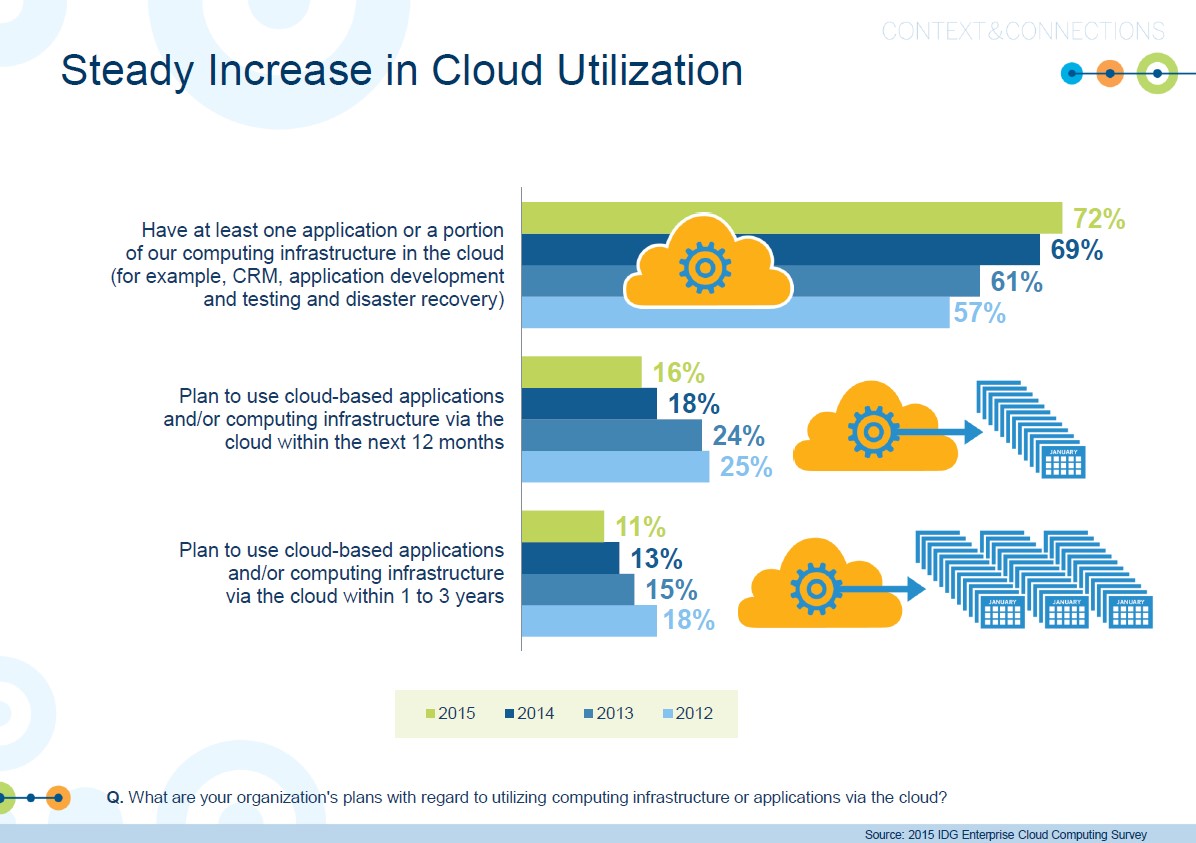Let’s be clear, today’s cloud as a vehicle for robust and flexible enterprise grade IT is here and it’s here to stay. Figures published by IDG Research’s 2015 Enterprise Cloud Computing Survey predict that in 2016 25% of total enterprise IT budgets will be allocated to cloud computing.

Steady increase in cloud utilisation. Source: IDG Enterprise Cloud Computing Survey.
They also reported that the average cloud spend for all the enterprises surveyed would reach 2.87M in the following year and that 72% of enterprises have at least one application running in the cloud already, compared to 57% in 2012. IDC in the meantime predicts that public cloud adoption will increase from 22% in 2016 to 32.1% within the next 18 months which equates to no less than 45.8% growth.

Wide range in cloud investments. Source: 2015 IDG Enterprise Cloud Computing Survey.
Now any organization looking to leverage the cloud needs a governing strategy. And research has shown that businesses with a vision are likely to be more efficient, successful and keep their costs down further than those who don’t. So let’s consider how a well rounded cloud strategy should be a priority for any business that doesn’t have one.
What are the key benefits of a cloud strategy?
A well thought out strategy will help an organization integrate cloud based IT into their business model in a more structured way. One that has given the proper consideration to all of its requirements.
1. Stay in control of your business in the era of on-demand cloud services
With the proliferation of cloud services available today. Shadow IT, that is to say the unsanctioned use of cloud services inside an organization, is a growing problem which if left unchecked runs the risk of a being a problem. Control it, before it controls you.
2. Better prepared infrastructure
Fully consider the potential ramifications and benefits which present themselves by using a structured approach. By properly mapping all of the requirements of it’s infrastucture, network, storage and compute resources a business will manage their migration with greater efficiency.
3. Increased benefit
Whether it’s a change in consumption models from owned to “pay-as-you-go” and the resulting shift from CAPEX to OPEX expenditures, potential for greater flexibility, efficiency and choice offered by the cloud over so called traditional IT. It’s seems obvious that having a well thought out strategy will magnify the value of these benefits.
4. Increased opportunity
Having a solid strategy is also likely to make for a bigger opportunity as an organization maps out it’s business and carefully thinks through the possibilities before taking making any changes.
Strategy formulation
Creating a migration strategy requires mapping out the suitability of all existing applications, weighing up their value against the costs and savings cloud services may offer and choosing which to prioritize.
1. Evaluate your applications
The first step is a business wide evaluation of all existing applications, categorized by two factors: business value and flexibility. With business value equating to the place and importance an asset holds in an organization and flexibility meaning it’s suitability for migration. It should seek to understand how they are deployed, how critical they are and whether moving them to the cloud will be cost effective or not.
2. Choose the right cloud model
The second is to determine the right cloud model for your requirements.
Private clouds, whether owned or leased, consist of closed IT infrastructures accessible only to a business which then makes available resources to it’s own internal customers. Private clouds are often home to core applications where control is essential to the business, they can also offer economies of scales where companies can afford larger, long term investments and have the ability to either run these environments themselves or pay for a managed service. Private cloud investments tend to operate on a CAPEX model.
Public clouds are shared platforms for services made available by third parties to their customers on a pay-as-you go basis. Public cloud environments are best suited to all but the most critical and expensive applications to run. They offer the significant benefit of not requiring large upfront capital investments because they operate on an OPEX model.
Hybrid clouds are made up of a mix of both types of resources working together across secured, private network connections. They can offer the benefits of both models but run the risk of additional complexity and can lessen the benefits of working at scale.
Why a clear strategy is vital for your business today?
The benefits of the cloud are real. Maximizing their value is therefore key to any business looking to leverage them. And the best way to do that is to have a well thought out strategy.

Thanks for sharing this post,
is very helpful article.